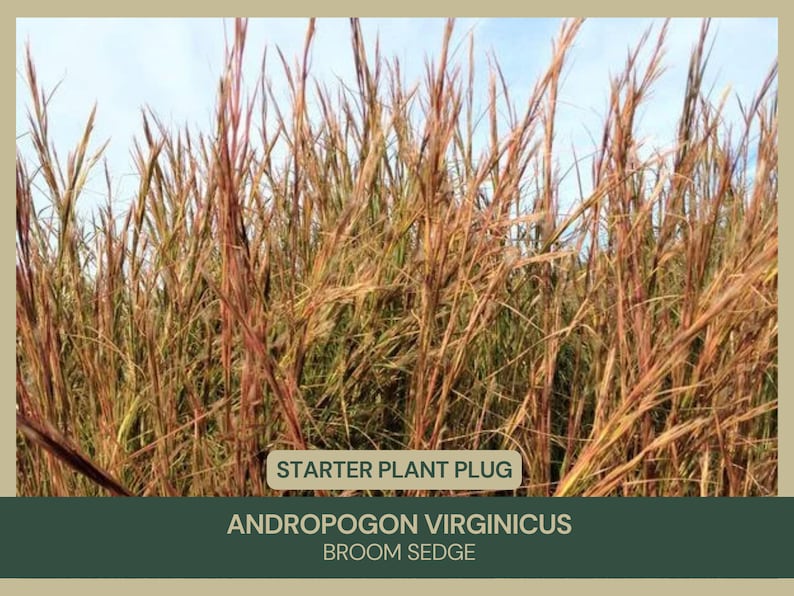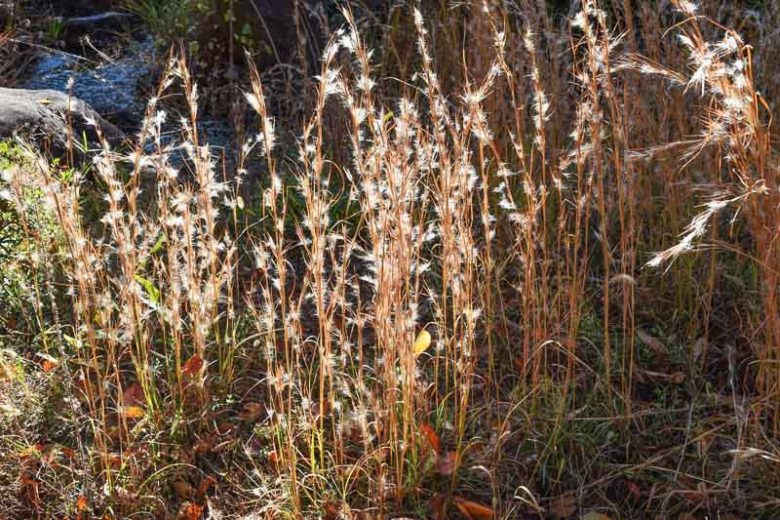
Andropogon virginicus
Common Name: Broomsedge Bluestem
Embracing the Wild: A Gardener’s Guide to Andropogon Virginicus
Andropogon virginicus, widely known as Broomsedge Bluestem, is a native perennial grass celebrated for its adaptability and distinctive appearance. This hardy grass is often utilized in naturalized settings, providing both ecological benefits and aesthetic interest.
Known for its fine-textured, upright clumps that turn a striking bronze-orange in fall.
Thrives in a variety of conditions, often found in meadows, open woods, and roadside areas.
Ideal for native plant gardens, erosion control, and as an ornamental grass in various landscapes.
Plant Care
Andropogon virginicus, commonly known as broomsedge bluestem, is a perennial grass that adds striking texture and color to landscapes, especially noted for its coppery to silver fall and winter coloration. Here’s how to care for this resilient and visually captivating grass:
Sunlight Requirements: This plant thrives in full sun. It needs a minimum of 6 hours of direct sunlight daily to develop its best form and coloration.
Watering Needs: Once established, Andropogon virginicus is highly drought-tolerant. It requires minimal watering, making it an excellent choice for xeriscaping or areas prone to dry spells. Water it during long periods of drought to maintain its health.
Soil Type and pH Preferences: Adaptable to a wide range of soil types, including poor soils, but it prefers well-draining conditions. It tolerates both acidic and alkaline pH levels, making it suitable for various garden settings.
Temperature and Climate Requirements: Hardy in USDA Zones 3-9, Andropogon virginicus is versatile and can withstand a wide range of temperatures, from hot summers to cold winters, without significant issues.
Pruning and Maintenance: Minimal maintenance is required. To keep your garden looking tidy, you can cut back the foliage in late winter or early spring before new growth starts. This timing allows the plant to maintain its winter interest and provides habitat for wildlife during the colder months.
Andropogon virginicus is not just a plant for visual appeal; it’s also valuable for soil stabilization and creating naturalistic or wildflower gardens. Its adaptability to various conditions and minimal care requirements make it a worthwhile addition to many landscapes.
How to Plant Andropogon virginicus
Planting Andropogon virginicus, commonly known as Broomsedge Bluestem, introduces a native warm-season grass to your garden or landscape, known for its striking fall and winter coloration. This grass provides texture and movement in the garden, with its upright clumps turning a brilliant orange-red in the fall. Here's how to successfully plant and care for Andropogon virginicus.
When to Plant
Best Time: The optimal time for planting Andropogon virginicus is in the spring, after the last frost, or in early fall. These times allow the plant to establish itself before the extremes of winter or summer.
Zone Considerations: Andropogon virginicus is hardy in USDA zones 2-9, showcasing its adaptability to a wide range of climates.
Selecting a Site
Sunlight: Full sun is best for this grass, as it thrives with 6 or more hours of direct sunlight daily.
Soil: Andropogon virginicus is not particular about soil type but prefers well-drained soils. It's tolerant of poor soils, including dry, sandy, or rocky conditions, making it a versatile choice for challenging sites.
Planting Steps
Soil Preparation: While Andropogon virginicus can tolerate poor soils, incorporating organic matter into the planting site can encourage vigorous growth. Loosen the soil to a depth of 12 inches.
Spacing: Space plants about 2-3 feet apart. Although individual plants are slender, they can spread to form dense clumps.
Planting Depth: Dig a hole as deep as the root ball and twice as wide. Set the plant in the hole so the top of the root ball is level with the surrounding soil surface. Backfill the hole, gently firming the soil to remove air pockets.
Watering: Water well after planting. While Andropogon virginicus is drought-tolerant once established, regular watering during the first growing season helps to establish a deep and extensive root system.
Ongoing Care
Watering: Mature Andropogon virginicus requires minimal watering, making it an excellent choice for xeriscaping or naturalized areas.
Fertilizing: Fertilization is generally not necessary. This grass prefers lean soils, and too much fertilizer can inhibit its natural growth habits and coloration.
Pruning: Cut back the foliage to about 4 inches above the ground in late winter or early spring before new growth starts. This maintains tidiness and allows new shoots to grow without competition from old growth.
Propagation
Division: Divide clumps in late winter or early spring every few years to rejuvenate older plants and manage their spread.
Seed: Andropogon virginicus can be propagated by seed sown directly in the garden in fall or spring. However, germination rates can be variable, and seedlings may take time to establish.
By incorporating Andropogon virginicus into your garden, you'll add a resilient, low-maintenance plant that offers year-round interest, particularly in the fall and winter months when its foliage and seed heads catch the light and provide striking visual interest.
Pests and Diseases
Broomsedge Bluestem is generally robust and resistant to pests and diseases.
Rarely troubled by pests or diseases, making it a low-maintenance choice for gardens.
Good air circulation and proper spacing help maintain plant health.
Feeding and Fertilizing
Asclepias incarnata Feeding and fertilizing Asclepias incarnata, commonly known as Swamp Milkweed, requires an understanding of the plant's specific needs to support its vibrant flowers and attractive foliage. Despite being relatively low-maintenance, appropriate nutrition can greatly benefit this native perennial, especially in garden settings. Here's a guide to effectively feeding and fertilizing your Asclepias incarnata.
General Guidelines
Minimal Fertilizer Requirement: Asclepias incarnata thrives in a variety of soil conditions but prefers moist, well-drained sites. It is generally low-maintenance and does not require high levels of fertilizer. Excessive fertilization can deter flowering and promote too much vegetative growth.
Soil Testing: Conducting a soil test can be helpful to determine if your soil lacks any essential nutrients that Asclepias incarnata may benefit from. This step is crucial to avoid over-fertilization, which can harm the plant and the environment.
Fertilizing Schedule
Early Spring Feeding: If needed, apply a light application of a balanced fertilizer in early spring as new growth appears. A fertilizer with an N-P-K ratio of 10-10-10, applied sparingly, can provide the necessary nutrients without overwhelming the plant.
Caution with Nitrogen: Be cautious with nitrogen-heavy fertilizers, as they can encourage foliage growth at the expense of flowers. Asclepias incarnata's primary attraction is its blooms, which are vital for attracting pollinators, especially monarch butterflies.
Organic Alternatives
Compost: Adding a layer of compost around the base of the plant in the spring can provide slow-release nutrients, enhance soil moisture retention, and improve soil structure, all beneficial to Asclepias incarnata's growth.
Mulching: A layer of organic mulch can help maintain soil moisture, suppress weed growth, and keep root temperatures stable. As it breaks down, mulch also contributes organic matter to the soil, feeding Asclepias incarnata indirectly.
By following these feeding and fertilizing tips, your Asclepias incarnata should thrive, producing lush foliage and vibrant flowers that attract a variety of pollinators to your garden. This plant's ability to support wildlife, particularly monarch butterflies, makes it a valuable addition to any garden aiming to promote biodiversity.
Seasonal Care
Spring
Cleanup: Start the season by removing any dead foliage and debris around your Andropogon virginicus plants. This cleanup helps prevent pests and diseases from taking hold.
Planting: Early spring, as soon as the soil is workable, is the perfect time to plant Andropogon virginicus. Planting during this time allows the plants to establish their root systems well before the summer heat intensifies.
Mulching: Apply a thin layer of organic mulch around your plants. The mulch helps maintain soil moisture, regulates soil temperature, and keeps weeds at bay. Be careful to avoid piling mulch directly against the plant stems to prevent rot.
Watering: Begin a regular watering schedule if the spring weather is drier than usual. While Andropogon virginicus is drought-tolerant, young plants especially benefit from consistent moisture as they establish.
Summer
Watering: Andropogon virginicus is highly drought-resistant and usually does not need extra watering once it's established. However, young or newly planted grasses might require occasional watering during extended dry spells.
Monitoring: Regularly check your plants for any signs of stress, disease, or pest infestation, although Andropogon virginicus is generally very resilient and pest-resistant.
Enjoying: Summer is when Andropogon virginicus truly begins to stand out, displaying its unique coloration and structural form, which adds depth and interest to your garden landscape.
Fall
Seed Heads: In the fall, Andropogon virginicus produces seed heads that contribute additional visual appeal. You have the option to leave these on the plants throughout the winter to enhance the garden's aesthetic and to provide food for birds.
Cutting Back: You can choose to cut the grass back in late fall for a neater garden appearance and to control self-seeding, or you might leave it standing to enjoy its beauty in winter and offer habitat for wildlife.
Winter
Protection: Andropogon virginicus does not require special care over the winter, as it is well-adapted to cold temperatures.
Planning: Use the winter months as an opportunity to assess your garden and decide if you wish to incorporate additional Andropogon virginicus plants based on their performance and aesthetic contribution to your garden in the past year.
Year-Round Tips
Fertilization: Typically, Andropogon virginicus doesn't need to be fertilized, particularly if it's planted in native or well-adapted soil types. Over-fertilizing can lead to excessively lush growth that is more susceptible to drought and stress.
Soil Care: Ensure your soil has good drainage. Andropogon virginicus can adapt to various soil types but prefers conditions that are not overly wet.
Pest and Disease Management: This grass variety is notably resistant to pests and diseases. Nonetheless, maintaining good cultural practices is crucial for keeping your plants healthy and thriving.
By adhering to this seasonal care guide, your Andropogon virginicus plants should flourish, providing beautiful foliage, fall color, and structural interest to your landscape throughout the year.
Plant Uses
Andropogon virginicus is versatile and serves multiple roles in the garden.
Perfect for naturalized or wildflower gardens, meadow plantings, and ecological restoration projects.
Provides habitat and food for wildlife.
Its fall and winter appearance offers ornamental value throughout the seasons.
Varieties and Cultivars
While Andropogon virginicus is a specific species, exploring other native grasses can add diversity.
Consider mixing with other native grasses and perennials for a varied, naturalistic landscape.
Each grass species offers unique characteristics, making them great for ecological and ornamental use.

Growing Tips and Tricks
Some additional insights can enhance your experience of growing Broomsedge Bluestem.
Prefers a sunny location with well-draining soil.
Tolerates poor soil conditions, making it suitable for challenging sites.
Requires minimal care, making it ideal for low-maintenance or natural landscapes.
Troubleshooting Common Problems
Broomsedge Bluestem is a hardy plant, but there are a few considerations for optimal growth.
If growth is sparse, check for adequate sunlight.
Overly rich or wet soil can inhibit its characteristic growth form and coloration.
Manage its spread in garden settings, as it can self-seed in favorable conditions.
Read our blogs for more gardening tips!




